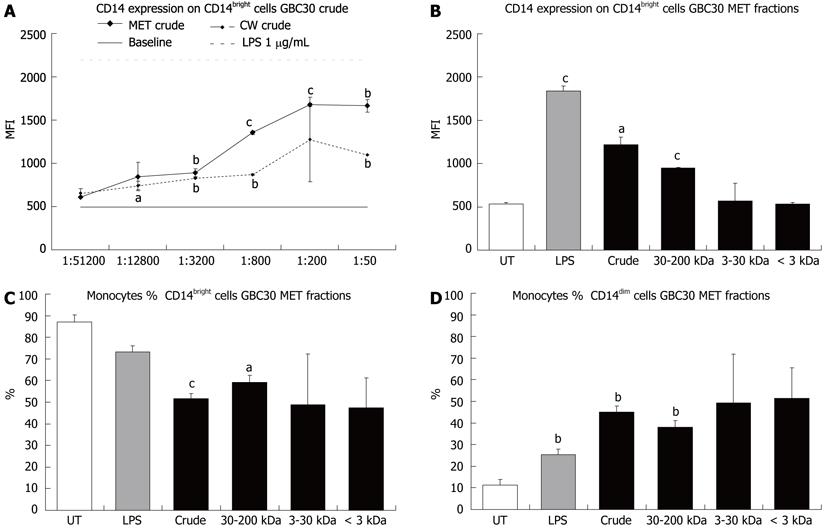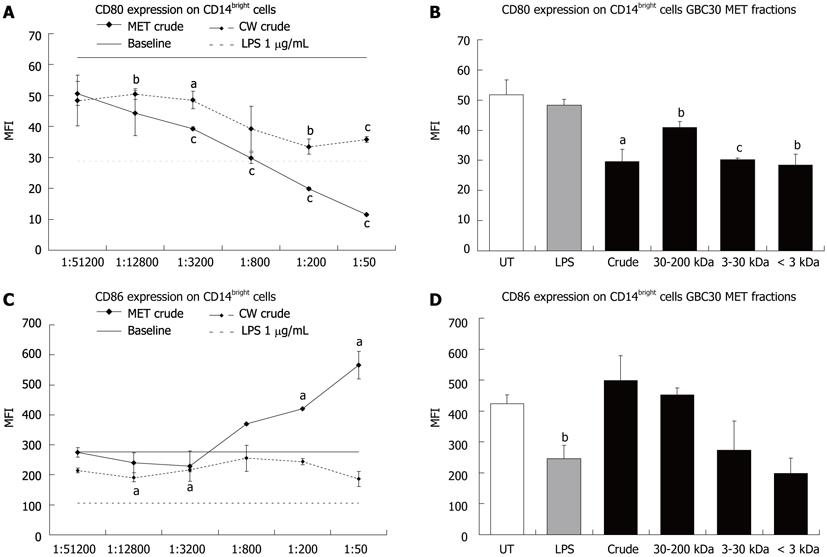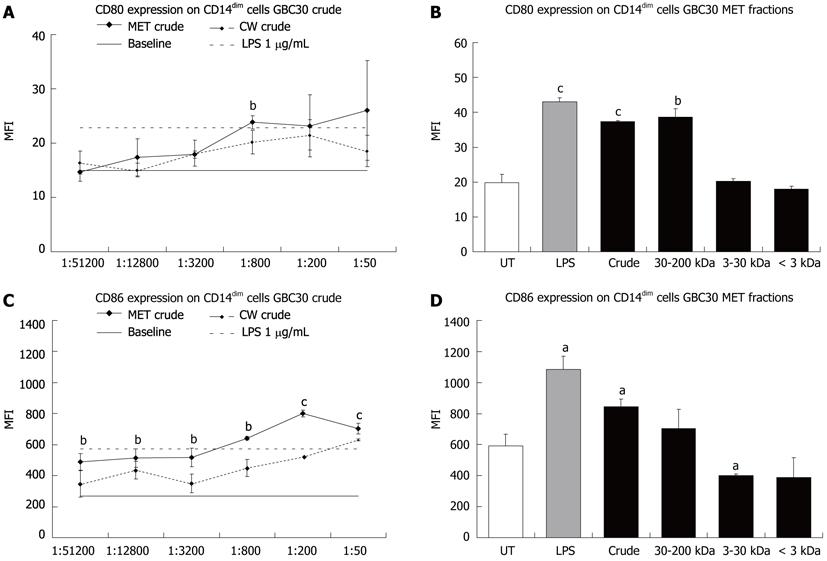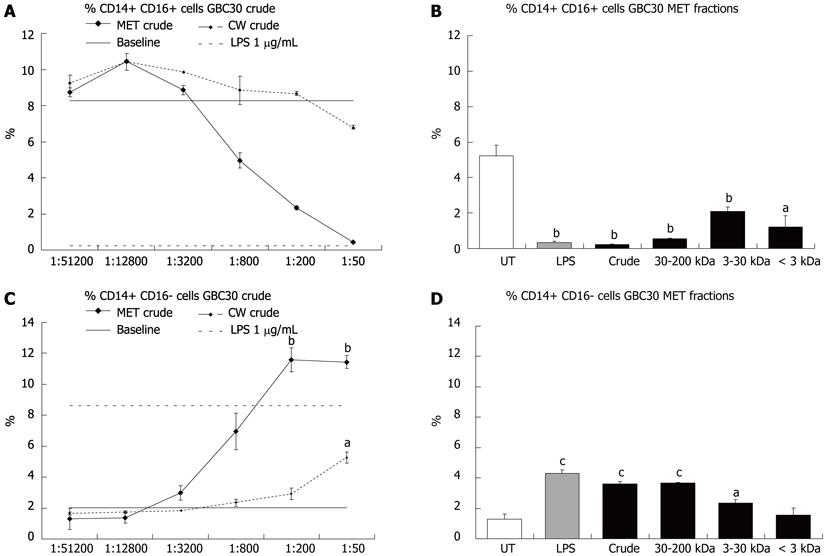Copyright
©2012 Baishideng Publishing Group Co.
World J Gastroenterol. Apr 28, 2012; 18(16): 1875-1883
Published online Apr 28, 2012. doi: 10.3748/wjg.v18.i16.1875
Published online Apr 28, 2012. doi: 10.3748/wjg.v18.i16.1875
Figure 1 CD14 expression on mononuclear phagocytes.
Mononuclear phagocytes present in 3-d peripheral blood mononuclear cell cultures exposed to either the Ganeden Bacillus coagulans 30 (GBC30) metabolites (MET), cell wall-enriched (CW), or MET fractions, were identified using electronic gating of the flow cytometry data by gating on forward scatter/side scatter followed by gating for CD14 positivity. A comparison was made between cells that were untreated (UT), exposed to lipopolysaccharide (LPS) or to the different GBC30 fractions. A: Comparison of CD14 mean fluorescence intensity showed a dose-dependent increase in CD14 expression in cells treated with crude MET. A milder increase was seen for cells treated with crude CW. The baseline indicates CD14 expression on untreated cells; B: The increase in CD14 expression was primarily caused by high molecular weight compounds present in MET; C: The percent of CD14bright cells in the mononuclear phagocyte population was decreased by all fractions of MET; D: The percent of CD14dim cells in the mononuclear phagocyte population was increased by treatment of cells with all MET fractions. Bar graphs show data from 1:200 dilutions of each MET fraction and lipopolysaccharide (1 μg/mL). aP < 0.05, bP < 0.01 and cP < 0.001. For each data point, the mean + SD are shown for each duplicate data set. Graphs show data representative of 1 out of 3 experiments. MFI: Mean fluorescence intensity.
Figure 2 Expression of the co-stimulatory molecules CD80 and CD86 on CD14bright mononuclear phagocytes from 3-d peripheral blood mononuclear cell cultures.
A: Comparison between the effects of serial dilutions of Ganeden Bacillus coagulans 30 (GBC30) crude metabolites (MET) or cell wall enriched (CW) fractions on CD80 expression on CD14bright cells showed dose-dependent decreases in CD80 expression. Both MET and CW reduced CD80 expression to levels similar to those seen with Lipopolysaccharide (LPS) treatment; B: A comparison of the effects of size-fractionated MET on CD80 expression on CD14bright cells shows that all MET fractions reduce expression; C: Comparison between the effects of serial dilutions of crude MET or CW on CD86 expression on CD14bright cells showed dose-dependent increases in CD86 expression when cells were exposed to the three most concentrated dilutions of MET. Treatment of cells with CW resulted in a uniform modest decrease in CD86 expression; D: The effect on increased CD86 expression is present only in the crude preparation of MET. Bar graphs show data from 1:200 dilutions of each MET fraction and lipopolysaccharide (1 μg/mL). aP < 0.05, bP < 0.01 and cP < 0.001. For each data point, the mean + SD are shown for each duplicate data set. Graphs show data representative of 1 out of 3 experiments. MFI: Mean fluorescence intensity; UT: Untreated.
Figure 3 Expression of the co-stimulatory molecules CD80 and CD86 on CD14dim mononuclear phagocytes from 3-d peripheral blood mononuclear cell cultures.
A: Comparison between the effects of serial dilutions of Ganeden Bacillus coagulans 30 (GBC30) crude metabolites (MET) or cell wall enriched (CW) fractions on CD80 expression on CD14dim cells showed that both MET and CW led to increased expression; B: The increase in CD80 expression following treatment of cells with MET was due to high molecular weight compounds; C: Comparison of CD86 expression on CD14dim cells exposed to crude fractions of MET or CW resulted in increased CD86 expression; D: Size-selected fractions of MET did not have uniform effects on CD86 expression on CD14dim cells. Crude MET increased expression while 3-30 kDa and < 3 kDa fractions decreased expression. Bar graphs show data from 1:200 dilutions of each MET fraction and lipopolysaccharide (1 μg/mL). aP < 0.05, bP < 0.01 and cP < 0.001. For each data point, the mean + SD are shown for each duplicate data set. Graphs show data representative of 1 out of 3 experiments. MFI: Mean fluorescence intensity; UT: Untreated; LPS: Lipopolysaccharide.
Figure 4 Changes in the percent of CD14+ CD16+ and CD14+ CD16- cell populations following exposure of 3-d peripheral blood mononuclear cell cultures to Ganeden Bacillus coagulans 30.
A: Exposure of cells to serial dilutions of Ganeden Bacillus coagulans 30 (GBC30) crude metabolites (MET) led to a strong dose-dependent decrease in CD14 CD16 double positive cells while exposure to cell wall enriched (CW) did not reduce this cell population; B: Treatment of cells with size-selected MET fractions show that all fractions of MET reduce the number of CD14+ CD16+ cells; C: The percent of CD14+ CD14- cells in peripheral blood mononuclear cell cultures increased in cultures treated with crude MET and CW. Treatment with MET resulted in a very strong dose-dependent increase while CW treatment produced a milder increase at the two highest concentrations; D: Treatment of cells with size-selected MET fractions show that only fractions containing high molecular weight compounds increase the number of CD14+ CD16- cells. Bar graphs show data from 1:200 dilutions of each MET fraction and lipopolysaccharide (1 μg/mL). aP < 0.05, bP < 0.01 and cP < 0.001. For each data point, the mean + SD are shown for each duplicate data set. Graphs show data representative of 1 out of 3 experiments. UT: Untreated; LPS: Lipopolysaccharide.
-
Citation: Benson KF, Redman KA, Carter SG, Keller D, Farmer S, Endres JR, Jensen GS. Probiotic metabolites from
Bacillus coagulans GanedenBC30TM support maturation of antigen-presenting cellsin vitro . World J Gastroenterol 2012; 18(16): 1875-1883 - URL: https://www.wjgnet.com/1007-9327/full/v18/i16/1875.htm
- DOI: https://dx.doi.org/10.3748/wjg.v18.i16.1875
















